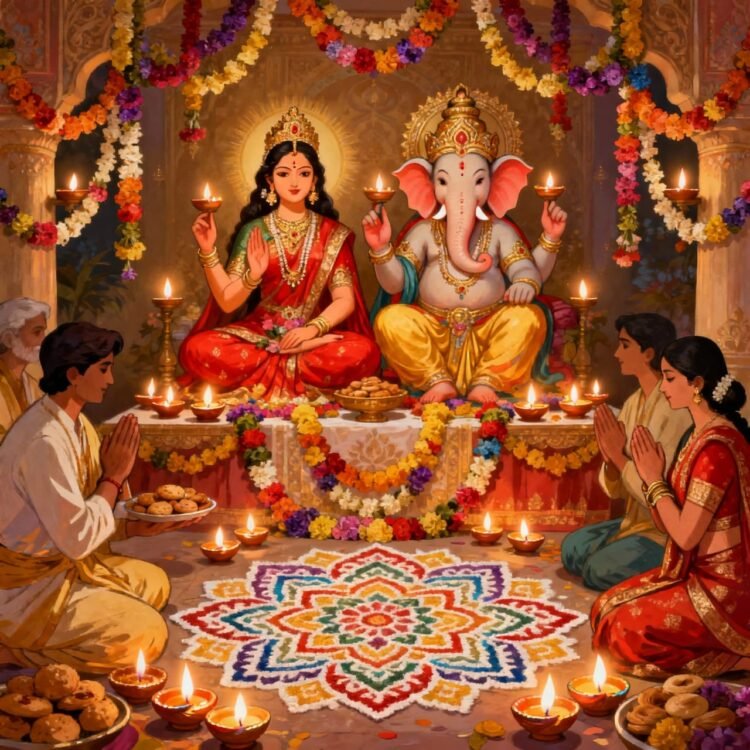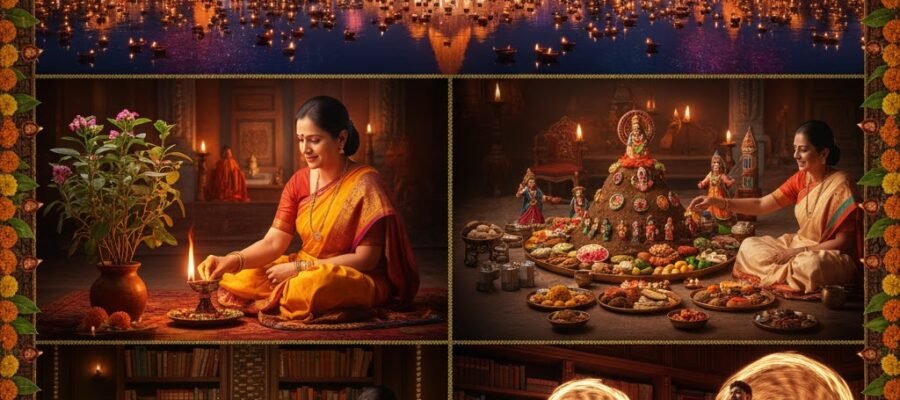No products in the cart.
Diwali: The Grand Festival of Indian Culture, Diverse Society, and Folk Traditions
Diwali, also known as Deepavali, is one of India’s most celebrated and vibrant festivals, symbolizing the victory of light over darkness and good over evil. Rooted in ancient traditions, it marks Lord Rama’s return to Ayodhya after 14 years of exile and is also associated with Goddess Lakshmi’s worship for wealth and prosperity.
By Akhilesh Chaudhary
Diwali (Deepavali) is India’s most comprehensive, scientific, and cultural festival. Celebrated across every region of the country, it reflects local colors, traditions, beliefs, and customs. The festival beautifully blends religious, social, scientific, commercial, historical, and regional diversity.
Historical and Cultural Background
The word Deepavali is derived from Deep (light) and Avali (row) — meaning “a row of lamps.” Excavations from the Indus Valley Civilization have revealed clay lamps, proving its ancient origins. In early times, it was linked to ancestor worship, the Yaksha–Gandharva traditions, and harvest celebrations.
In the Vedic era, it gained deep religious and cultural significance through the worship of Goddess Lakshmi and the prosperity of both kings and common people.
Diwali symbolizes the confluence of Vedic, Tantric, and folk traditions — representing knowledge, prosperity, and creativity.
The Five-Day Deepotsav: Religious and Scriptural Significance
Diwali is not just a one-day celebration but a five-day festival, with each day having its unique religious and cultural meaning:
- Dhanteras (Kartik Krishna Trayodashi): The day when Goddess Lakshmi and Lord Dhanvantari emerged from the churning of the ocean (Samudra Manthan). It is considered auspicious for buying gold, silver, and utensils — symbolizing health, wealth, and prosperity.
- Narak Chaturdashi / Chhoti Diwali (Kartik Krishna Chaturdashi): Marks Lord Krishna’s victory over the demon Narakasura. Special baths (Abhyang Snan) and house cleaning are significant on this day.
- Main Diwali / Lakshmi–Ganesha Puja (Kartik Amavasya): Celebrated to welcome Lord Rama back to Ayodhya after 14 years of exile. Lamps are lit, and Goddess Lakshmi and Lord Ganesha are worshipped for wealth, wisdom, and auspicious beginnings.Rituals: Clean homes, decorate with lamps, flowers, sweets, fruits, coconuts, panchamrit, and chant mantras.
Cultural Meaning: Invoking prosperity, success, and well-being in homes and businesses. - Govardhan Puja (Kartik Shukla Pratipada): Commemorates Lord Krishna lifting the Govardhan Mountain to humble Lord Indra. The Annakut feast and Tulsi–Vrindavan worship are central features.
- Bhai Dooj (Kartik Shukla Dwitiya): Celebrates the sacred bond between brother and sister, linked to Yama and his sister Yamuna.
Other Religious Views:
- Jainism: Diwali marks the Nirvana (liberation) of Lord Mahavira.
- Sikhism: Celebrated as Bandi Chhor Divas, commemorating Guru Hargobind Ji’s release from captivity.
The Significance of Kali Puja (Shyama Puja)
In Bengal, Odisha, and Assam, the night of Diwali is dedicated to Goddess Kali. Rooted in Tantric traditions and the worship of divine power (Shakti Sadhana), rituals involve the idol of Kali, 108 hibiscus flowers, bel leaves, earthen lamps, lemon garlands, and offerings. Devotees recite mantras, Shaktipath, and Kali Chalisa.
Economic and Commercial Importance
- Dhanteras: Auspicious for purchasing gold, silver, vehicles, and electronics.
- Chopda Pujan: Traders perform rituals before opening new account books.
- Diwali is India’s biggest annual commercial season — marked by a boom in clothing, jewelry, sweets, vehicles, and household sales.
Scientific and Health Aspects
- Post-monsoon deep cleaning, lighting lamps, fire, and Abhyang Snan help eliminate germs.
- Diyas, flowers, and rangoli generate positive energy.
- Emphasis on cleanliness and hygiene promotes well-being.
Social, Cultural, and Environmental Significance
- Promotes unity through family gatherings, gift exchanges, and sweets.
- Encourages charity, service, and helping the needy.
- Advocates Green Diwali — eco-friendly lamps, natural decorations, and awareness campaigns.
- Women and children express creativity through rangoli, alpana, and lamp decoration.
Regional Traditions and Diversity
- North India: Associated with Lord Rama’s return to Ayodhya; Tulsi worship.
- Bengal–Odisha: Kali Puja and Tantric practices.
- Maharashtra–Goa: Celebration of Narakasura’s defeat.
- Gujarat: New Year, business rituals, and rangoli festivals.
- Punjab–Haryana: Guru Hargobind Ji’s Bandi Chhor Divas.
- South India: Ritual baths and worship on Narak Chaturdashi.
- Nepal: Celebrated as Tihar or Swanti — honoring animals, Goddess Lakshmi, and siblings.
- Tribal Areas: Natural colors, folk songs, and lamp-lighting rituals.
Bihar’s Folk Tradition of “Hukkaloli Bhanjne”
In Bihar’s Kosi, Mithilanchal, and Ang regions, people perform Hukkaloli Bhanjne on Diwali night — lighting fireballs made of bamboo, jute, or cloth dipped in kerosene.
Folk Songs:
“Hukkaloli bhanjaye chhi, machhar ke jharakvai chhi” or “Lakshmi ghar, daridra bahar.”
Scientific Meaning: The fire and smoke help disinfect the surroundings.
Cultural Message: Togetherness, children’s joy, and environmental awareness.
Gharonda Worship and Girls’ Creativity
In Mithila and Bengal, young girls build small clay houses (gharonda) and light lamps — symbolizing feminine creativity and the sanctity of home life.
Tulsi–Vrindavan and Govardhan Worship
In North India, the Tulsi plant and Vrindavan are worshipped at home. Govardhan Puja and the Annakut tradition are integral to regional celebrations.
Confluence of Vedic, Tantric, and Folk Traditions
Diwali beautifully unites Vedic hymns, Tantric practices, and folk customs. Worship of Lakshmi, Kali, and Saraswati represents wealth, power, and knowledge respectively.
Environmental and Modern Perspectives
- Green Diwali focuses on sustainability — using eco-friendly lamps, herbal baths, natural décor, cleanliness drives, charity, and organic materials.
- Promotes green crackers, clay lamps, flower rangoli, and biodegradable items — blending environmental and health consciousness.
13 Global and International Influence
- Among Indian diaspora communities, Diwali holds deep cultural, religious, and economic importance.
- It is celebrated collectively in countries like Sri Lanka, Thailand, Malaysia, Fiji, the USA, and the UK.
The Modern Ayodhya Deepotsav
Ayodhya’s Deepotsav has evolved into a grand modern tradition. The city glows with millions of lamps, and cultural programs, Ramlila performances, and festivities mark the occasion.
Other Rituals, Fasts, and Local Practices
- In Gujarat–Maharashtra, Kali Chaudas is observed before Diwali — symbolizing the end of negative energies.
- Each region incorporates its own rituals, stories, and spiritual practices.
- In Bihar and nearby regions, people light lamps for ancestors, worship Diwat, Tulsi, and perform various household rituals.
Poetic Message
May the five lamps of Diwali ignite new awareness,
Bringing self-reliance, discipline, and light everywhere.
May family bonds grow strong, love fill every home,
Harmony and understanding flourish, joy ever bloom.
Let hearts unite, spreading the message of peace,
Erasing differences, walking hand in hand with ease.
Let duty awaken — nation and service our base,
A clean and safe India — our shared embrace.
Let nature stay pure and green, life be bright again,
Each Diwali lamp bringing new light to every domain.
Diwali is not merely a festival of lights — it is a grand celebration of knowledge, prosperity, health, creativity, unity, social harmony, environmental care, and cultural diversity.
The Ayodhya Deepotsav, Bihar’s Hukkaloli, Bengal’s Kali Puja, Mithila’s Gharonda, and modern environmental and commercial initiatives make Diwali a multidimensional and vibrant festival of humanity.

















